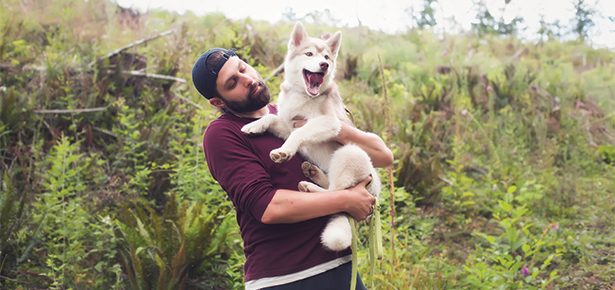

When Should You Bring Your New Puppy Home?
Dr. Stanley Coren tells us the optimal time to take your puppy home
I was speaking to a well-respected breeder of Soft Coated Wheaten Terriers and mentioned to her that I had picked up my new puppy from his breeder at the age of nine weeks. She looked at me with some amazement and said, “Nine weeks? That’s leaving the puppy in his litter for an awfully long time. I believe that the scientific data says that the optimal time to send a puppy to its new home is at seven weeks—49 days to be precise. I never let a puppy go much earlier than that, regardless of a buyer pressuring me to let a puppy go at age six weeks, but I do try to get the puppies adopted as close to seven weeks as possible. Socially speaking, the litter is a very competitive environment. I believe that if the puppies stay in the litter too long they start to develop a pecking order and a strong pattern of dominant or submissive behaviours around their littermates. I think that these carryover when they leave and can be a source of social and behavioural problems later on.”
The underlying psychological issue about what age to bring pups home involves socialization. You can think of socialization as a process where the dog learns how to deal with the living things in its environment—specifically dogs and people. The scientific foundation for our knowledge of socialization in dogs begins with the classic book Genetics and the Social Behavior of the Dog by John Paul Scott and John Fuller which was published in 1965. It summarized 13 years worth of research which was done at the Jackson Laboratories in Bar Harbor, Maine.

Scott and Fuller never explicitly say anything about seven weeks being an optimal time to take a dog out of its litter, although they do comment that it is inadvisable to take a dog away from its litter before seven weeks of age. The conclusion that seven weeks of age is an important marker seems to come from comments made by Clarence Pfaffenberger, the guiding force behind Guide Dogs for the Blind, who felt that before seven weeks dogs were not trainable. Pfaffenberger’s conclusion was picked up by Richard Wolters, a very popular dog writer during the 1960s and 70s, who wrote that if you want to have an easily trained dog you should “buy your puppy and take him home at the exact age of 49 days.” Perhaps because of Wolter’s popularity and Pfaffenberger’s prestige, these comments were accepted as scientific gospel by dog breeders around the world.
There is good evidence that the age that a puppy is taken away from the litter and sent to its new home does make a difference. An Italian veterinarian and two researchers from the Faculty of Veterinary Medicine at the University of Milan recently published an article in the scientific journal Veterinary Record that looked at what happens to puppies who are separated from their litter at an early or a later age. They tested 70 dogs who were separated from their litter and adopted between the age of 30 and 40 days (that is between the fifth and sixth week) and compared them to 70 puppies that were adopted at 60 days of age (which is between the eighth and ninth week).
Questionnaires were sent to the owners of all of the 140 dogs when the dogs were adults between the age of 18 months and seven years. Very specifically, the questionnaires asked about behavioural problems in the dogs. Their results were unambiguous—the dogs separated from their litter at an early age did not fare as well. The researchers summarize their results saying, “The odds of displaying destructiveness, excessive barking, fearfulness on walks, reactivity to noises, toy possessiveness, food possessiveness, and attention-seeking were significantly greater for the dogs that had been removed from the litter earlier during the socialization period.” Furthermore, the effects were much greater in dogs purchased from pet stores who most likely had less opportunity to interact with people and other dogs on a regular basis.
This research report clearly shows that early separation from the litter is bad for puppies and results in a higher incidence of problems when the dogs are adults, in all probability because it interrupts their behavioural development by taking them away from needed social interactions before they are fully socialized.
Nonetheless I was intrigued by this apparently well accepted notion that 49 days or seven weeks of age is the optimal time for a puppy to go to its new home. So I started an extensive literature search that extended all the way back to the 1940s, and continued up to the present and covered all of the veterinary and behavioural literature that I could access. I came up with not one single study suggesting that there is something special or valuable about choosing seven weeks as the time to send a puppy to its new home. I mentioned this to a friend of mine who is an established dog trainer and she laughed and suggested, “Well seven is a lucky number, and 7×7 gives you 49. So maybe this 49 day rule was chosen by breeders in the hope that it would give the puppy some good luck in his future life.” I suppose that in the absence of scientific data her explanation makes as much sense as any other. However, in England the politicians are apparently not as superstitious and they have recently passed a law specifying that puppies sold in pet stores may not be younger than eight weeks of age.
While it is certain that it is harmful to remove puppies from their litter at too young an age (prior to seven weeks), there is still a debate as to just how long a breeder should keep puppies before giving them up to their new owners. There is some consensus among breeders that smaller dogs are a bit more fragile and some breeders will not let them go until they are 10 or even 12 weeks of age. But much longer than that is not advisable; the data from Scott and Fuller suggest that the dogs should be in their new home earlier than 14 weeks of age in order to bond with their new owners.
There do appear to be pitfalls associated with keeping puppies in their litter for too long a time. Not too long ago I sat in the living room of a woman who is a respected breeder of white standard Poodles. The room had six such adult dogs sprawled on dog beds and blankets. When I asked her why she had so many dogs she sighed and pointed at one of them and said, “When Lucy, that’s her over there, had a litter of four pups, I decided to keep them until they were 12 weeks of age in order to make sure that they were fully socialized and psychologically ready for their new homes. The problem was that after the puppies were with me for 12 weeks I felt that they were mine—part of my family—and who could let a family member be sold? So since then I have instituted a policy that all puppies must be on their way to their new homes by the age of nine to 10 weeks!”
Join the newsletter and never miss out on dog content again!
"*" indicates required fields
By clicking the arrow, you agree to our web Terms of Use and Privacy & Cookie Policy. Easy unsubscribe links are provided in every email.





